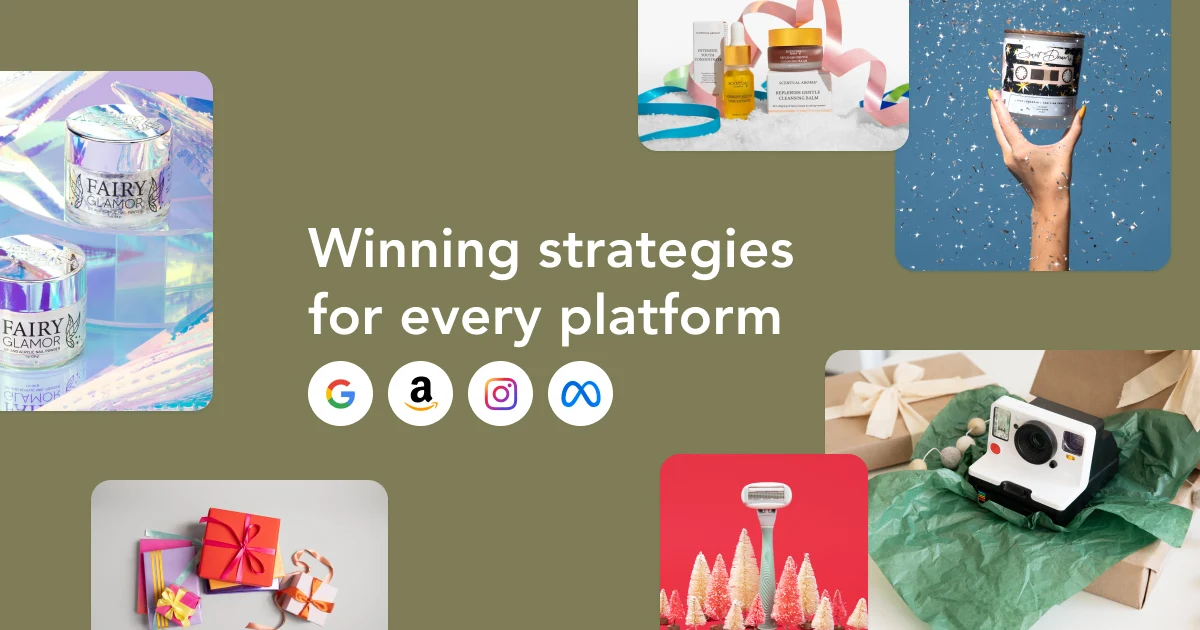Our mission at soona is to make the internet a more beautiful place. And what makes the internet more beautiful? The access and abundance of quality content. Since our founding in 2019, we have seen the value of our work time and again. It is the difference maker for a small merchant just getting started, helping them accelerate their business and their brand. And ultimately, creativity is what inspires us to try something new, like products and services, and makes our shopping and social experiences more rich.
Creativity is a super power. One that often requires sacrifice and dedication to develop and hone. This rarity is what makes it feel so special. And it’s also why it’s not that surprising that we are living in a time when generative images are exceptionally exciting. Who doesn’t want to feel “creative” without all the time spent and failed attempts to get there?
When you look at the buzz around artificial intelligence today, it’s easy to come to the conclusion that the tools on the market are seeking to replace the creative process, and as a result, creative people. Why hire a writer when you can use an AI created blog post? Why employ graphic designers when you can use Canva’s AI? And as it pertains to soona, why hire a photographer or videographer when you can type a prompt into a box and get an asset in seconds?
It really comes down to this essential question: Do you believe that AI should be used as a tool to replace human creativity? Or do you believe it should be used to speed up and amplify our access to our innate creative capabilities?
At soona, we fall firmly into the second camp. AI used to accelerate the creativity in all of us is a meaningful unlock.
Like digital files to cameras…
And word processing to writing…
There is a real opportunity for AI to be used to expand our productivity, reduce barriers to entry and improve the economics of experimentation. It all comes down to how this technology is deployed.
As a company, we have watched as many in the market have either pioneered recklessly or stood on the sidelines. As creatives and human beings, we feel called to provide leadership on this issue. That’s why we are releasing our Ethically Creative AI position paper. It’s 3 key frameworks for solving the inherent challenges we face as an industry while respecting that progress is upon us.
{{tools-ad}}
Ethically Creative AI:
1. Requires AI Authorship.
AI generated assets should be identifiable as AI generated. If it’s to be treated as an art, we imagine a future where galleries, portfolios and artists themselves explicitly call out when an asset was generated entirely by artificial intelligence. Much in the way that a photographer clarifies if something was shot on film or digital or how a painter provides details, such as watercolor on linen, to assist the viewer in appreciating the context of the creative process, an AI generated image that also references any relevant open source or proprietary libraries used to supply the resulting asset. If AI seeks to be treated as equal to human-generated activities, then the fair expectation should be to provide an honest account of what was required of the artist.
Beyond images, we also believe that these disclosures should apply anywhere that human labor is being displaced. For example, any blog post or article that was created by AI should be labeled with AI as its author.
Where Copyright was the long-standing marker of ownership across the web, we now see a need for an AI-specific identification that provides the appropriate parties credit for their contributions. We fully support the Content Authenticity Initiative in their work to provide a tech-first approach to attribution.
In the context of commerce, we also are recommending to all merchants that they are transparent and honest about their wholly AI generated assets which appear on their websites and in marketing. The Federal Trade Commission’s Truth in Advertising mandate ensures that consumers are not in any way defrauded by businesses. Just this year, ecommerce fashion brand, Fashion Nova, settled with the FTC for $4.2 million because they allegedly blocked negative reviews of its products from being posted to its website.
AI toes a very fine line between what is “truthful” and what is not. And merchants who do not honestly portray that their content is representative of generative imitations of their product and are not the actual product itself, run the risk of breaking Truth in Advertising mandates. As was clear in the case of Fashion Nova, it is not just about what merchants SAY in their advertising and marketing, it is what they fail to be honest about that can find them under scrutiny.
2. Respects Cultural Norms.
The rules of decorum we expect from human artists and creatives should be applied to artificially generated creative. Artists are often on the bleeding edge of setting trends, pushing boundaries and exploring our cultural conventions. This is an essential part of the creative process. Nothing is contextless. For example, we rightly expect artists and creatives not to participate in cultural appropriation, the degradation of a protected class or the dissemination of hate speech. The same etiquette expectations should be applied to the AI powered creative process.
At soona, we have seen too many vendors approach us with AI tools that change the hair texture or skin color of a human model in an image, essentially creating one button click access to the creation of digital blackface. Not only would we frown upon this if the model themselves had done it, but we would be equally appalled by all other creatives involved in that kind of production. This kind of tooling should be avoided in the strictest possible terms.
3. Seeks consent.
Scraping of creative materials is theft. Training models should be based on express consent. We are past the point of no return with Open AI and most of the open source tools available today. Since it is unlikely that we will change the existing dominant players for the sins of their past, we are instead advocating for a future where all content that is fed into models is provided based on the act of “opt-ing in” vs. requiring creatives and creators from opting out. This consent must also extend to other common place structures in the creative industry, such as model and location releases.
This proactive approach solves two key problems.
First, it respects the contributions of the creator and provides a framework for compensation structures to be developed. In order to ensure the preservation of the value of creativity as a career and a practice, we must create economic structures that value those who predate this AI revolution. Ultimately, any person involved in this work from the engineering and science perspective will also tell you that the quality of the data that enters into these models will directly influence the quality that they are able to generate.
Second, brands employing these tools must have confidence that they are not somehow unwittingly participating in a form of derivative theft. We need a clear business practice that outlines fair use of media in these new creative processes.
In the coming months, soona will be increasingly deploying AI into our product in order to improve our customer experience and further make accessible the power of creativity for your business. Already, our tool Magic Script, has created hundreds of AI scripts for TikTok and Instagram videos. And in just a matter of weeks, we will be releasing “Listing Fixer,” a first of its kind recommendation engine that will pinpoint creative deficiencies in a product listing page and give merchants real time scoring on where to prioritize improvements.
We are just getting started with this exciting work. And indeed, the entire industry is in its infancy. But before we get too far, we hope you will join us in sharing and practicing a principled approach to AI as it is deployed into the work we do every day.
Our mission at soona is to make the internet a more beautiful place. And what makes the internet more beautiful? The access and abundance of quality content. Since our founding in 2019, we have seen the value of our work time and again. It is the difference maker for a small merchant just getting started, helping them accelerate their business and their brand. And ultimately, creativity is what inspires us to try something new, like products and services, and makes our shopping and social experiences more rich.
Creativity is a super power. One that often requires sacrifice and dedication to develop and hone. This rarity is what makes it feel so special. And it’s also why it’s not that surprising that we are living in a time when generative images are exceptionally exciting. Who doesn’t want to feel “creative” without all the time spent and failed attempts to get there?
When you look at the buzz around artificial intelligence today, it’s easy to come to the conclusion that the tools on the market are seeking to replace the creative process, and as a result, creative people. Why hire a writer when you can use an AI created blog post? Why employ graphic designers when you can use Canva’s AI? And as it pertains to soona, why hire a photographer or videographer when you can type a prompt into a box and get an asset in seconds?
It really comes down to this essential question: Do you believe that AI should be used as a tool to replace human creativity? Or do you believe it should be used to speed up and amplify our access to our innate creative capabilities?
At soona, we fall firmly into the second camp. AI used to accelerate the creativity in all of us is a meaningful unlock.
Like digital files to cameras…
And word processing to writing…
There is a real opportunity for AI to be used to expand our productivity, reduce barriers to entry and improve the economics of experimentation. It all comes down to how this technology is deployed.
As a company, we have watched as many in the market have either pioneered recklessly or stood on the sidelines. As creatives and human beings, we feel called to provide leadership on this issue. That’s why we are releasing our Ethically Creative AI position paper. It’s 3 key frameworks for solving the inherent challenges we face as an industry while respecting that progress is upon us.
{{tools-ad}}
Ethically Creative AI:
1. Requires AI Authorship.
AI generated assets should be identifiable as AI generated. If it’s to be treated as an art, we imagine a future where galleries, portfolios and artists themselves explicitly call out when an asset was generated entirely by artificial intelligence. Much in the way that a photographer clarifies if something was shot on film or digital or how a painter provides details, such as watercolor on linen, to assist the viewer in appreciating the context of the creative process, an AI generated image that also references any relevant open source or proprietary libraries used to supply the resulting asset. If AI seeks to be treated as equal to human-generated activities, then the fair expectation should be to provide an honest account of what was required of the artist.
Beyond images, we also believe that these disclosures should apply anywhere that human labor is being displaced. For example, any blog post or article that was created by AI should be labeled with AI as its author.
Where Copyright was the long-standing marker of ownership across the web, we now see a need for an AI-specific identification that provides the appropriate parties credit for their contributions. We fully support the Content Authenticity Initiative in their work to provide a tech-first approach to attribution.
In the context of commerce, we also are recommending to all merchants that they are transparent and honest about their wholly AI generated assets which appear on their websites and in marketing. The Federal Trade Commission’s Truth in Advertising mandate ensures that consumers are not in any way defrauded by businesses. Just this year, ecommerce fashion brand, Fashion Nova, settled with the FTC for $4.2 million because they allegedly blocked negative reviews of its products from being posted to its website.
AI toes a very fine line between what is “truthful” and what is not. And merchants who do not honestly portray that their content is representative of generative imitations of their product and are not the actual product itself, run the risk of breaking Truth in Advertising mandates. As was clear in the case of Fashion Nova, it is not just about what merchants SAY in their advertising and marketing, it is what they fail to be honest about that can find them under scrutiny.
2. Respects Cultural Norms.
The rules of decorum we expect from human artists and creatives should be applied to artificially generated creative. Artists are often on the bleeding edge of setting trends, pushing boundaries and exploring our cultural conventions. This is an essential part of the creative process. Nothing is contextless. For example, we rightly expect artists and creatives not to participate in cultural appropriation, the degradation of a protected class or the dissemination of hate speech. The same etiquette expectations should be applied to the AI powered creative process.
At soona, we have seen too many vendors approach us with AI tools that change the hair texture or skin color of a human model in an image, essentially creating one button click access to the creation of digital blackface. Not only would we frown upon this if the model themselves had done it, but we would be equally appalled by all other creatives involved in that kind of production. This kind of tooling should be avoided in the strictest possible terms.
3. Seeks consent.
Scraping of creative materials is theft. Training models should be based on express consent. We are past the point of no return with Open AI and most of the open source tools available today. Since it is unlikely that we will change the existing dominant players for the sins of their past, we are instead advocating for a future where all content that is fed into models is provided based on the act of “opt-ing in” vs. requiring creatives and creators from opting out. This consent must also extend to other common place structures in the creative industry, such as model and location releases.
This proactive approach solves two key problems.
First, it respects the contributions of the creator and provides a framework for compensation structures to be developed. In order to ensure the preservation of the value of creativity as a career and a practice, we must create economic structures that value those who predate this AI revolution. Ultimately, any person involved in this work from the engineering and science perspective will also tell you that the quality of the data that enters into these models will directly influence the quality that they are able to generate.
Second, brands employing these tools must have confidence that they are not somehow unwittingly participating in a form of derivative theft. We need a clear business practice that outlines fair use of media in these new creative processes.
In the coming months, soona will be increasingly deploying AI into our product in order to improve our customer experience and further make accessible the power of creativity for your business. Already, our tool Magic Script, has created hundreds of AI scripts for TikTok and Instagram videos. And in just a matter of weeks, we will be releasing “Listing Fixer,” a first of its kind recommendation engine that will pinpoint creative deficiencies in a product listing page and give merchants real time scoring on where to prioritize improvements.
We are just getting started with this exciting work. And indeed, the entire industry is in its infancy. But before we get too far, we hope you will join us in sharing and practicing a principled approach to AI as it is deployed into the work we do every day.
























